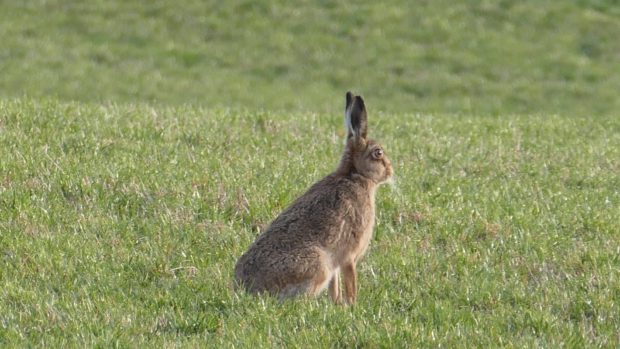It was the second time in as many weeks that I had spotted a brown hare in this Kinross-shire field, and this one was moving with real purpose. The reason soon became apparent because suddenly another hare, hidden in the grass, reared-up before it and there was a temporary stand-off.
The two hares stared each other out for several seconds, before the one that had been approached loped away to the far corner of the field, while the other sat on its haunches and watched, seemingly unsure what to do next.
This is the season of the ‘Mad March Hares’ when brown hares will square up to each other and often engage in paw-flailing boxing matches. But this encounter was much more benign altogether and it was hard to know if this was a male approaching a female, or whether there was some other mix in the pot.
Female hares are only receptive to mate for one day a month, so dominant bucks tend to guard them zealously from the attention of other males. This leads to much chasing and also the famous ‘boxing’ encounters, which usually involves females fending-off the unwelcome attentions of over-amorous males.
Hares have a quite remarkable turn of speed and the expression to ‘kiss a hare’s foot’, meaning ‘to be late’, alludes that for those that hesitate, the hare will be gone, leaving behind just the footprint.
The early 20th Century naturalist Frances Pitt kept a pet hare, which held a mix of behaviours ranging from “extreme timidity and boldness, of rashness and suspicion, of cunning and of the most fragrant silliness”.
She described him as “….bold as brass, yet a more temperamental creature never walked. The slightest strange thing would upset him. I have seen him flee in crazy panic from his own shadow moving on the wall, temporarily mad with terror and liable to injure himself in his headlong, heedless flight”.
I get that feeling, too, when watching brown hares; the impression that they are clever creatures but with complex personalities.
I see fewer hares with each passing year, a trend that worries me. The reasons for their nationwide decline are complex, including the intensification of agriculture. But a new threat is looming with recent reports from England that the deadly rabbit viral haemorrhagic disease, and possibly even myxomatosis, may have made the transmission jump from rabbits to hares.
Hopefully this is not the case, or are just isolated occurrences, for the potential consequences are catastrophic, especially since hares don’t breed at the same prolific rate as rabbits, making it difficult to replenish populations depleted by disease.
As I watched these Kinross-shire hares, I wondered whether we are on the cusp of an unfolding calamity in our fields where this once ubiquitous animal disappears for ever. I pray not, for they are such special animals; sleek of build, temperamental in nature and with a multifarious mind that would be simply wonderful to dip into.
Info
Hares produce up to three litters a year, comprising one to four young (leverets). They are born fully furred and with their eyes open in a scrape in the ground known as a ‘form’.











